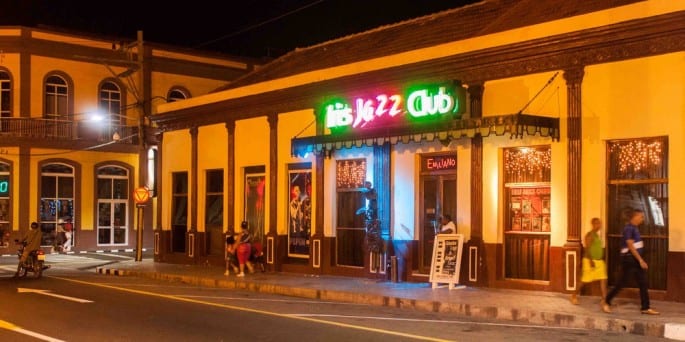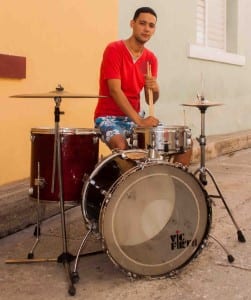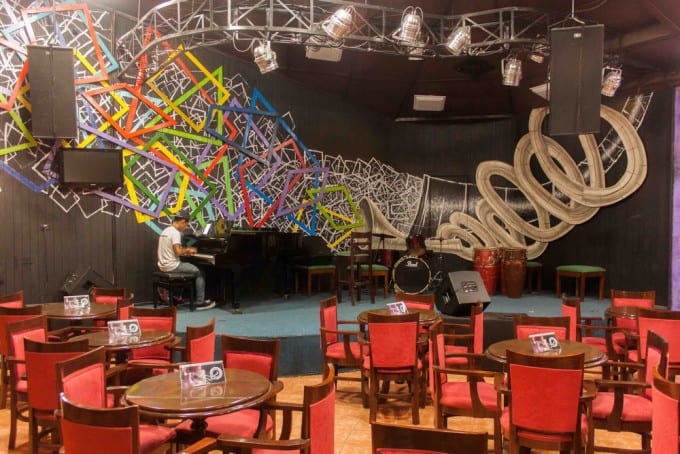The Jazz Dream in Santiago de Cuba

Carlos Melian Moreno (Progreso Semanal)
HAVANA TIMES — There’s a part of the heart somewhere that gets sad if you don’t dress it up, if you don’t make it pretty, says Orlando Fuentes, drummer and director of Influencia, Santiago de Cuba’s most successful jazz band.
The 22-year-old has shortness of breath and reeks of nicotine. He lives in a small house full of smokers and ash trays, with his parents (both professional musicians) and his brother, who is studying guitar. With the index finger and thumb of the hand he smokes with, he points to that tiny part of the heart that can get depressed. It’s almost 2 centimeters big.

He set up his band nearly 5 years ago to compete in Jojazz, the most important Cuban festival for young instrumentalists and composers. In 2011, they won second prize. In 2012, they went home with the trophy for Best Performance.
These achievements earned them renown in their provincial setting and, shortly afterwards, while still studying at the Esteban Salas Conservatory, they were granted the status of professional musicians without a test.
When asked whether these are good times for jazz in the city, Orlando replies that they aren’t, that jazz isn’t and has never been in vogue in Santiago de Cuba.
27-year-old free-jazz pianist Camilo Bess switched over from traditional Cuban music after playing with a jazz musician during a concert held at the Alliance Francaise in 2008. “There, I started to see that music isn’t only designed to have people dance and have a good time, that it should make the musician go into an ecstatic trance.”
I tell him there are those who say he is crazy. He replies impassively: “there are people who don’t understand what I do.” He set up a musical project and, two years later (in 2010 and 2011), he performed at the Jojazz festival. He won third prizes on both occasions. One year later, he opened the Iris Jazz Club.
Living the Dream
The opening of the Iris Jazz Club in 2012 pulled Orlando Fuentes and Camilo Bess from unpaid performances at the city’s cultural get-togethers. The club opened three years ago, across the busy thoroughfare of Plaza de Marte, in a locale that was home to an unreliable, State-run coffee shop and restaurant for decades: a glass-enclosed, fly-ridden, stagnant place.
Today, it is the most elegant and least frequented locale in the city. Cuban musicians and bands Bobby Carcasses, Interactivo, Zule Guerra, Yasek Manzano, Carlos Miyares and, more recently, Arturo O’Farril, have performed at this new venue.
“What is and would be a dream to me?” says Frank, a young man who walks around the Plaza de Marte night and day, speaking of projects that never come to fruition. “I think the idea came from Alberto Lescay, the sculptor who’s a jazz fan. It is a nice attempt at brining culture to a city devoid of refinement, but it doesn’t pay off.”
“The locale was financed by the government,” Dailin Carrillo, a mid-level production technician employed by the club, explains. “The décor, the interior design,” he goes on, referring to the brick wall, the photo collections, the half-light, the crescent-moon-shaped stalls, “these imitative those of other jazz clubs and are the work of the Caguayo Foundation (chaired by Alberto Lescay). There are also some pieces donated by Carlos Rene Aguilera and Lescay himself.”

State Management, Private Management
Adriana Aseff works at Iris’ air-conditioned bar. “People came at first, but jazz didn’t interest them much.” Above us, a twisting cable hangs from the ceiling. It is the only table without a lampshade above. The lamps at the other ceramic tables are missing the bulbs.”
Over forty, Adriana is energetic, young in spirit, and rather masculine. Her voice – her singing and speaking voice – is a bit like her. She performed at the Iris for some time but, after several musicians left her band, she had to make a pause to reorganize. She is a musical education graduate from the Pedagogic Institute, where she teaches. Her music is somewhere between folk, funk and certain jazz styles.
What we are seeing, Aseff ventures to say, is what has always happened: “we don’t have a place, an audience. There’s also the fear audiences will not like what we do.” When the club opened, Lescay invited her to perform because her work (which tends to break with traditional melodies) had something to do with the genre.
“The place filled up at first,” Aseff explains. “It was affordable, people came to have a good time, because it had swing, see, but, later, they rented out the place to someone, prices went up and people stopped coming. And one makes one’s money from the people who come.”
In search of more efficient management, the locale was rented out to a private operator months ago. Two State companies, Compay Tiahgo and Coyaba, managed the place for a while and then left. The first left to begin managing the growing number of hostels in town (nearly all State guest houses in the city), the second, according to an official from the Provincial Music and Concert Center, wasn’t offering a service in step with the high quality cultural offer the locale aims to maintain.

It seems that jazz movements aren’t likely to get far out in the provinces. Another similar club failed in Holguin around 5 years ago, after losing its musicians (who were also Jojazz prize winners).
Let’s call him Adrian. Adrian used to play the clarinet in Holguin. He had a Jojazz trophy that had made him the town’s hero. Adrian was sitting by himself on the porch of his house, on an iron swing. He was looking out at the street and the void, holding the clarinet. Suddenly, he placed it over his mouth and blew into it, but no note came out, only air, air and a string of saliva. That was the last time I saw him.
About six or seven jazz bands are hired by the Iris, the only club that hires jazz musicians. In addition to those mentioned above, soloist Zulema Iglesias, Giselle y su group, Francisco y su piquete, Ivan Acost and Cuba Somos play at the club.
Promotion
All of the locale’s employees concur on one thing: “they play for art’s sake, for music’s sake.” 26-year-old Giselle Lage has a different perspective on the problem: “Yesterday, an Italian couple who are friends of mine sat and waited to see me from 8 till 10 pm. They were the only people who came that night. I sang for them only. Those are the kinds of situations where one can say one is singing for music’s sake. I think that, sometimes, generally speaking, people take advantage of that. They’re making us work for very small audiences.”
As she sees it, “the Iris Jazz Club doesn’t have a television or radio promo. The programming tends to change and isn’t always up to date.” In 2015, Giselle, represented by her mother, took her perfect smile and powerful throat to Havana, on promotional trips that have come out of her own pocket. She has sung at El gato tuerto, Mediodia en TV, Radio Taino and other venues and programs.

Waiting
The success of the Iris Jazz Club appears imminent to Alexis Duany, a promoter at the Provincial Music Center.
Like millions of other Cubans, he regards the lifting of the US blockade as the light at the end of the tunnel, referring to the recent visit of 2014 Grammy winner Arturo O’Farril (son of the renowned trombonist Chico O’Farril) to the island, and a performance where 18 American and 13 Finnish musicians played. “It is an illustration of what the Iris could be in the short term,” Duany stresses, “a gem. In fact, it’s already a gem, a real gem.”
Musicians have no other choice but to wait. To hold their breath and wait. I asked drummer Orlando Fuentes about the future. He replies with a yawn:
“I want a future in jazz, but I can’t say whether in Santiago de Cuba, Havana or another country altogether.”






Saga holidays go to Santiago. They should put it on their itinerary.
I spent several months in Cuba (not Havana) around this time last year , what struck me was how little Jazz is available there on vinyl or cds , or even on T V music shows , another negative consequence of the U S blockade ? ? probably . However I believe if more of Cuban people in particular young Cubans had exposure to Jazz in all it’s varied forms , this genre would grow in popularity considerably . Well done to Orlando Fuentes and Camilo Bess for opening Iris Jazz club ! !
Music is the universal language! Great future to you all and buena suerte!